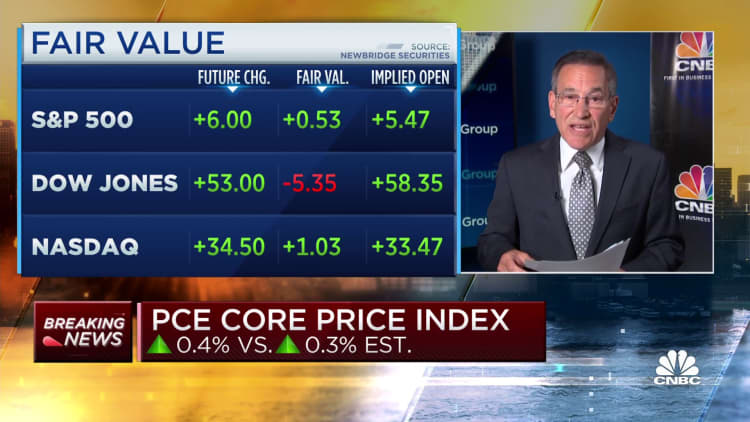Inflation rose 0.4% in April and 4.7% from a year ago, according to key gauge for the Fed

Inflation stayed stubbornly high in April, potentially reinforcing the chances that interest rates could stay higher for longer, according to a gauge released Friday that the Federal Reserve follows closely.
The personal consumption expenditures price index, which measures a variety of goods and services and adjusts for changes in consumer behavior, rose 0.4% for the month excluding food and energy costs, higher than the 0.3% Dow Jones estimate.
On an annual basis, the gauge increased 4.7%, 0.1 percentage point higher than expected, the Commerce Department reported.
Including food and energy, headline PCE also rose 0.4% and was up 4.4% from a year ago, higher than the 4.2% rate in March.
Despite the higher inflation rate, consumer spending held up well as personal income increased.
The report showed that spending jumped 0.8% for the month, while personal income accelerated 0.4%. Both numbers were expected to increase 0.4%.
Price increases were spread almost evenly, with goods rising 0.3% and services up 0.4%. Food prices fell less than 0.1% while energy prices increased 0.7%. On an annual basis, goods prices increased 2.1% and services rose by 5.5%, a further indication that the U.S. was tilting back toward a services-focused economy.
Food prices rose 6.9% from a year ago while energy fell 6.3%. Both monthly PCE gains were the most since January.
Markets reacted little to the news, with stock market futures pointing higher as investors focused on improving prospects for a debt ceiling deal in Washington. Treasury yields were mostly higher.
Fed implications
“With today’s hotter-than-expected PCE report, the Fed’s summer vacation may need to be cut short as consumers’ vacations fuel spending,” noted George Mateyo, chief investment officer at Key Private Bank. “Prior to today’s release, we believe that the Fed may have been hoping to take the summer off (i.e., pause and reassess), but now, it seems as if the Fed’s job of getting inflation down is not over.”
The report comes just a few weeks ahead of the Fed’s policy meeting June 13-14.
The Fed targets annual inflation around 2%, meaning that the current levels remain well above the goal and leading to the likelihood that the aggressive moves the central bank has made over the last year or so could remain intact.
One way the Fed’s rate hikes are supposed to work is by bringing down demand. The April spending numbers, however, show that consumers have continued spending in the face of both higher rates and strong inflation, meaning policymakers may have more to do.
Immediately following the report, market pricing swung to a 56% chance that the Fed will enact another quarter percentage point interest rate hike at the June meeting, according to the CME Group. There are only two key inflation-related data points before then, with the May nonfarm payrolls report due next Friday and the consumer price index out June 13.
Along with the uptick in consumer spending, demand for durable goods also unexpectedly increased 1.1% in April, according to a separate Commerce Department report. Economists surveyed by Dow Jones had been looking for a decline of 0.8%. Excluding transportation, which increased 3.7%, new orders fell 0.2%.
Consumers had to dip into savings to keep up their spending, with the personal savings rate of 4.1% representing a 0.4 percentage point drop from March.
The data comes amid a high level of uncertainty about where the economy heads from here. Expectations for a recession later this year are high, considering rising interest rates, an expected credit crunch in the banking industry and consumer pressure on a variety of fronts.
However, a report Thursday showed the economy grew more in the first quarter than initially reported, with real GDP rising at a 1.3% annualized pace compared with the previous estimate of 1.1%.
Real gross domestic income, however, fell 2.3% in the quarter. GDI measures all money earned for goods and services and usually moves in conjunction with GDP. Averaging the two measures shows a quarterly growth decline of 0.5%, according to the Commerce Department.
At the same time, the goods trade deficit soared 17% in April to $96.8 billion, according to Commerce’s advanced economic indicators report released Friday. Exports are a net negative for GDP.
Still, Citigroup economists expect the Fed to raise its forecasts for inflation and GDP when it releases its updates at the June meeting.
Minutes released Wednesday from the May Fed meeting showed policymakers split on their next move, as members sought to balance higher-than-expected inflation against the spillover effects from troubles in the banking industry.
For all the latest World News Click Here
For the latest news and updates, follow us on Google News.

